Model C Evaluation Board
Overview
The RTL87x2G model C evaluation board is compatible with the following daughter boards:
The RTL87x2G evaluation board model C provides a hardware environment for user development, including:
5V to 3.3V & 1.8V power module
Support QSPI (Group1) and I8080 (Group2) display interface
Support Audio module (AMIC, DMIC) interface
Red LED and RGB LED module
Audio Power Amplifier Module
FT232RL for USB to UART
备注
If you require modules for the Model C evaluation board, please contact RTK FAE for assistance.
EVB Blocks Distribution
Distribution diagrams of blocks on the front and back of the model C evaluation board are as following:

EVB model C blocks distribution Diagram-Front (click to enlarge)
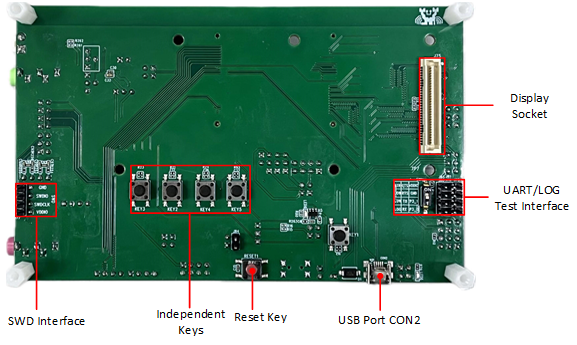
EVB model C blocks distribution Diagram-Back (click to enlarge)
The following introduces the main blocks on the evaluation board in counterclockwise order.
Blocks |
Introduction |
|---|---|
EVB Daughter Board Socket |
Used to connect the EVB daughter board with an anti reverse insertion mechanism |
Model C evaluation board supports QSPI (Group1) and I8080 (Group2) display interface |
|
Supports USB port CON1, CON2, or battery to power the display |
|
Supports download mode and normal mode |
|
Provides power consumption measurement points for 1.8V and 3.3V |
|
Two pins socket to connect a single cell Li-ion battery |
|
Used to power EVB and communicate with RTL87x2G via USB |
|
Provides power voltage options of 1.8V and 3.3V |
|
Reset Key |
Pressing this key resets the system |
External Power Supply |
Provides external power supply of 1.8V and 3.3V |
Used to connect the RTK SD Nand Flash daughter board |
|
MIC Socket |
Supports 3.5mm audio interface |
MIC Interface |
Used to connect the external MIC daughter board |
SWD Interface |
Used to SWD debug |
24bits ADC Interface |
24bits ADC, AIN0-3 can be used as four single-ended inputs. AIN0-1 and AIN2-3 can be used as two differential inputs |
Provides four red LEDs and one RGB LED |
|
Uses the ALC105-VF. It is a stereo Class-D audio amplifier with maximum output power of 3W per channel |
|
Independent Keys |
KEY2, KEY3, KEY4, KEY5 are connected to P10_2, P10_1, P9_2 and P9_1 respectively |
Used to power the EVB and connect USB to UART chip FT232 for burning programs or debugging logs |
|
Display Socket |
Used to connect display screen |
EVB Interfaces Distribution

EVB model C interfaces distribution Diagram-Front (click to enlarge)

EVB model C interfaces distribution Diagram-Back (click to enlarge)
EVB Blocks and Interfaces Introduction
EVB Daughter Board
EVB Daughterboard can be removed and replaced. There is an anti-reverse insertion mechanism between the motherboard and the daughterboard. RTL8762GTP and RTL8762GTH daughter board is compatible with the RTL87x2G evaluation board model C.
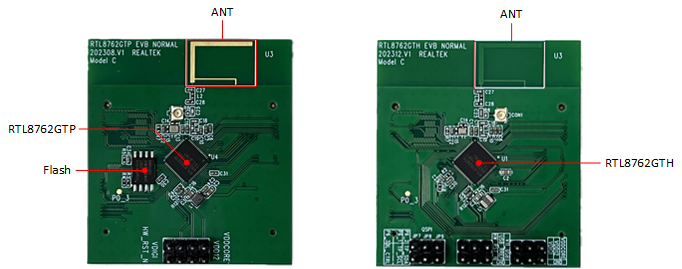
RTL8762GTP and RTL8762GTH daughter board
Power
- USB Port CON1
USB port CON1 is used to power the model C evaluation board and communicate with RTL87x2G via USB.
- USB Port CON2
USB port CON2 is used to power the model C evaluation board and connect USB to UART chip FT232RL for burning programs or debugging logs.

USB Port CON1&2 of EVB model C
- Li-ion Battery Socket
The model C evaluation board supports battery power supply. By connecting the jumper marked in red, the lithium battery can be charged by USB.
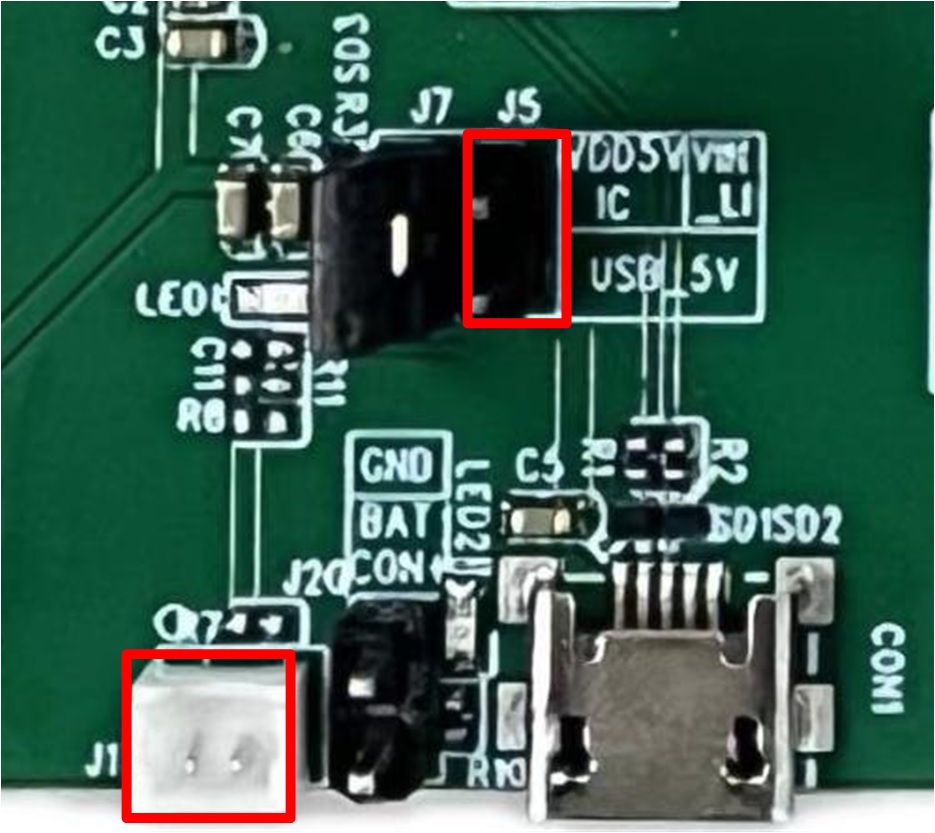
The model C evaluation board is powered by battery
- IC Power Supply Voltage Selection
VDD_VBAT/VDDIO/VDDIO_EXT can choose 1.8V or 3.3V power supply according to the actual application, with default connection of 3.3V, as shown below. Power input pins are introduced as follows:
Pin Name |
Function |
|---|---|
V33_USB |
Power supply for USB transceiver |
VD33_PA |
Power supply for the internal +14dBm radio power amplifier |
AVDD |
Power supply for the internal 24bits ADC |
VDD_VBAT |
Power supply for the internal regulator and analog circuitry |
VDDIO |
Power supply for PAD and Flash |
VDDIO18 |
Power supply for MCM PSRAM |
VDDIO_EXT |
Power supply for external devices |
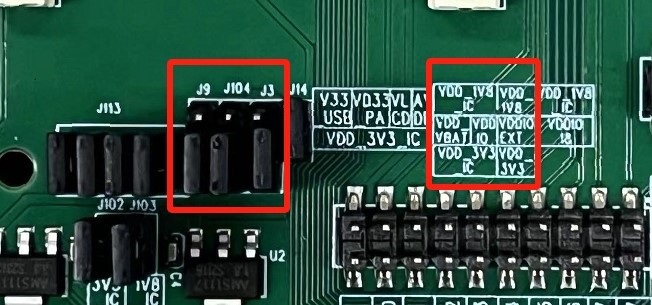
Power select of EVB model C
备注
VDDIO and VDDIO_EXT power supplies should be consistent.
When using RTL8762GTP daughter board, VDDIO18 in J14 can only choose 1.8V.
EVB Interfaces
UART/LOG Test Interface
- Download Mode:
Need to set the dial switches SW1/SW2 to ON position, which will pull down the LOG pin, then press reset button or power on again to enter download mode.
- Normal Mode:
Need to set the dial switches SW1/SW2 to 1 position, which will pull none the LOG pin, then press reset button or power on again to start running the program. Log pin can be used for debug. Please refer to normal mode connection.

UART/LOG test interface-front of EVB model C

UART/LOG test interface-back of EVB model C
- Red LED and RGB LED module
Red LED and RGB LED module can be connected to the pin header within the red box through jumpers, allowing the default GPIO to control the LED and RGB. Alternatively, you can use Dupont wires to connect the pin header on the right side of the red box to any GPIO for controlling the LED and RGB.

LED&RGB interface of EVB model C
- SD Nand Flash Interface
SD NAND Flash interface can be used with the RTK SD NAND Flash daughter board. Insert SD NAND into the connection socket marked in red. Please pay attention to the order of the plugging positions to prevent a reverse connection.

SD NAND Flash interface and daughter board of EVB model C

SD NAND Flash power control of EVB model C
备注
Normal Mode: When using the SD Nand Flash module, you need to use a jumper cap to connect the J35 pin header.
Low Power Mode: Remove the jumper cap from J35, and then connect the pin headers marked in the blue box in J37 to any GPIO. When the GPIO output is high, the SD Nand Flash module work normally. When the GPIO output is low, the module does not work.
EVB Pin Assignment
There is an anti-reverse insertion mechanism between mother board and daughter board.
Please refer to the latest RTL87x2G IOPin Information table about the pin assignment of daughter board.
EVB User Guide
EVB Power Connection
The evaluation board can be powered independently using USB port CON2, in which case the USB communication function of RTL87x2G cannot be used, but programs can be normally burned into RTL87x2G. The power connection of the evaluation board is shown below. All jumpers marked in the red box need to be connected.

Power supply with USB port CON2 of EVB model C
If all functions of the daughterboard (including USB communication) needs to be used, both the USB Ports CON1 and CON2 on the evaluation board need to be connected. In this situation, the power supply connection is shown below, and all jumpers marked in the red box need to be placed.

Power supply with USB Port CON1&2 of EVB model C
Download Mode Connection
P0_3 (log) is the download mode selection pin. When P0_3 is pulled low, performing a hardware reset or power cycling will put the system into download mode. Use a jumper to connect P3_0 to RX and P3_1 to TX. Set the DIP switch to the ON position (pulling P0_3 low), and then power on the board or perform a hardware reset to enter download mode. After the program download is complete, set the DIP switch back to the 1 position (check both sides to ensure it's correct), allowing P0_3 to return to a floating state. Finally, press the hardware reset button or power cycle the board, and the program will run normally.
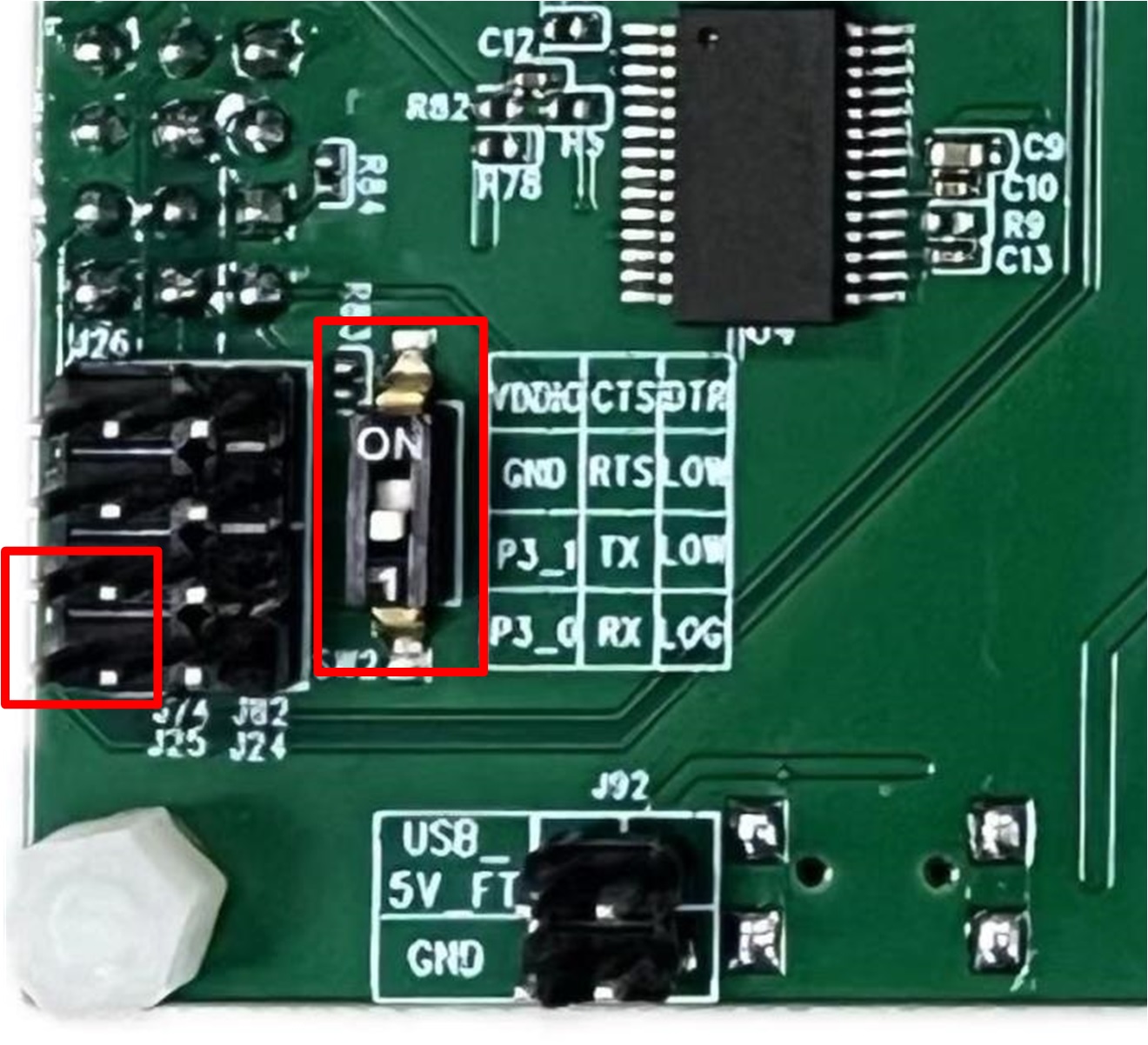
Download mode of EVB model C
Normal Mode Connection
Please confirm that the dial switches SW1/SW2 are set to the 1 position. Then place the jumper on the red box in the figure below. Connect P0_3 (log) to RX, P3_0 and P3_1 are disconnected from RX and TX respectively. On the computer side, use the Debug Analyzer software tool via the USB port CON2 to read the operating information of the sub-board chip.
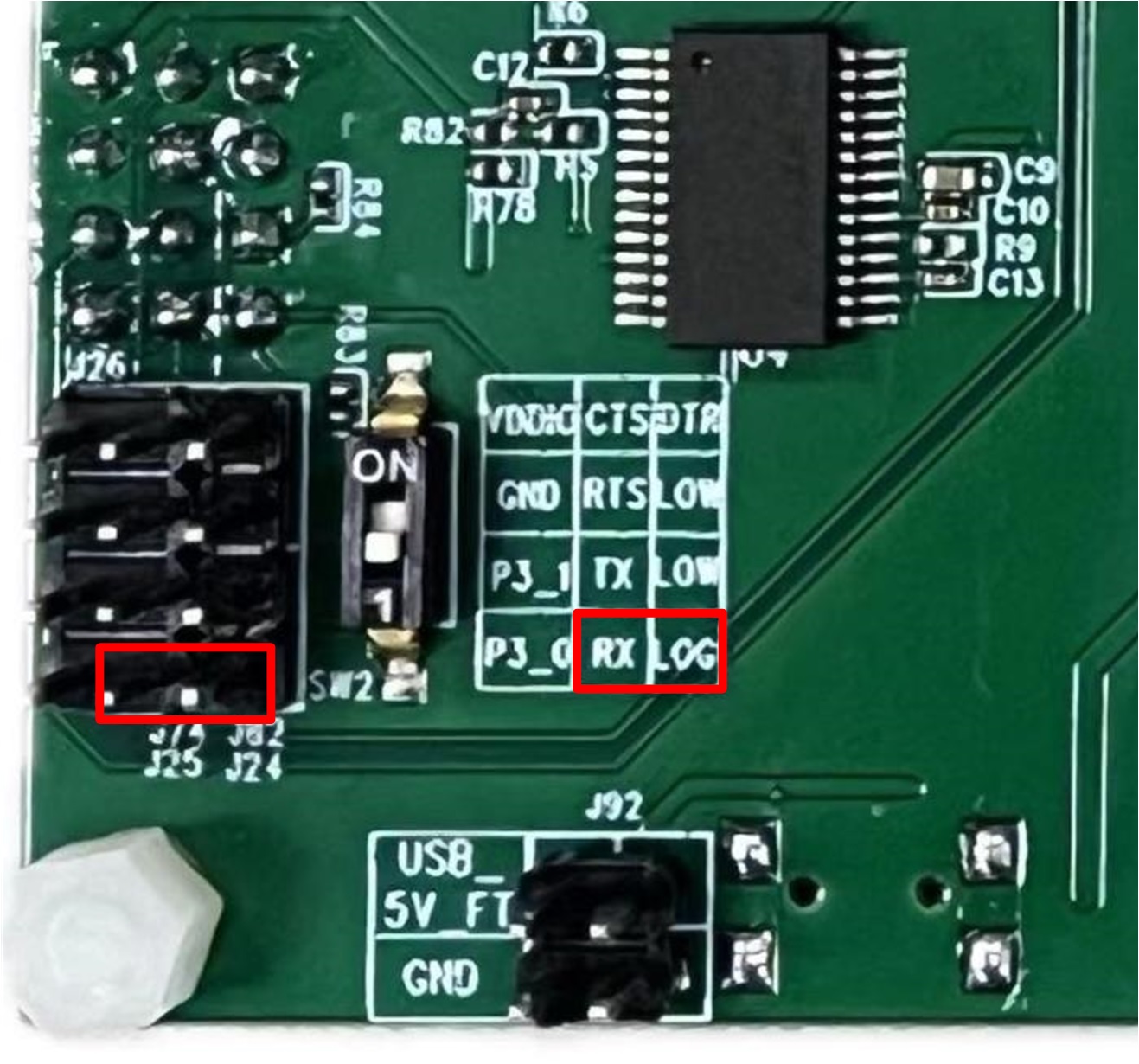
Normal mode connection of EVB model C
Audio Power Amplifier Module
The PD signal can be connected to any GPIO, and then the audio power amplifier module can be enabled by pulling it high and disabled by pulling it low. Users can choose to use 5V or 3.3V power supply of the audio power amplifier module by connecting jumpers.
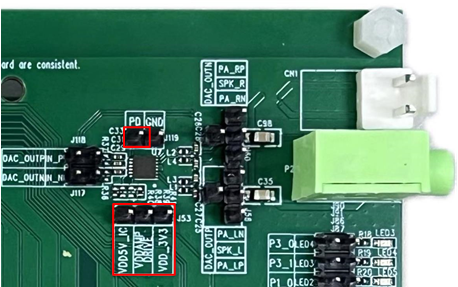
PA power supply of EVB model C
The default connection is the jumper shown in red on the left side of Figure. It is used to mono mode for 3.5 mm jack headphone.
Audio can also be output through the white VH-2A Socket to connect to the speaker on the right side of Figure. It is necessary to connect the jumper shown in red and add R262 and R261 when using differential output.

PA interface of EVB model C
Display Interface
- Power Selection
It supports USB port CON1, CON2, or battery to power the display.

Display power selection of EVB model C
- Interface Type Selection
Display type interface can be selected by setting the status of LCD_IM[1:0] based on used screen. Please refer to the datasheet of display driver chip for details.
PIN Name |
QSPI (Group1) interface |
I8080 (Group2) interface |
|---|---|---|
P2_3 |
TP_RST |
TP_RST |
P2_4 |
TP_INT |
TP_INT |
P5_7 |
TP_SCL |
TP_SCL |
P1_3 |
TP_SDA |
TP_SDA |
P1_4 |
LCD_BL_CTRL |
LCD_BL_CTRL |
P4_3 |
QSPI_CS |
8080_D7 |
P3_4 |
QSPI_DCX |
|
P4_0 |
QSPI_CLK (PHY) |
8080_D4 |
P3_3 |
QSPI_SIO3 |
|
P3_2 |
QSPI_SIO2 |
|
P4_1 |
QSPI_SIO1 |
8080_D5 |
P4_2 |
QSPI_SIO0 |
8080_D6 |
P3_6 |
LCD_RESX |
LCD_RESX |
P0_5 |
LCD_TE (VSYNC) |
8080_D1 |
P0_2 |
8080_WR# |
|
P1_5 |
8080_DCX |
|
P1_6 |
8080_RD# |
|
P0_7 |
8080_D3 |
|
P0_6 |
8080_D2 |
|
P0_4 |
8080_D0 |
|
P0_1 |
8080_LCD_TE |
|
P0_0 |
8080_CS# |
IC Power Consumption Test Interface
The model C evaluation board provides power consumption measurement points for voltages of 1.8V and 3.3V.
When the IC is powered by 3.3V, disconnect J102 before measuring. Then connect the ammeter to measure the current passing through J102.
When the IC is powered by 1.8V, disconnect J103 before measuring. Then connect the ammeter to measure the current passing through J103.

IC Power Consumption Measurement Points
备注
Please properly connect the jumper caps according to the introduction of power supply input pins and the power consumption measurement scenarios.
To avoid extra power consumption, it is necessary to turn off log printing.
To avoid the effect from debugging equipment, please do not connect UART, SWD, and debugger.
When using an external DC power supply, the jumpers of J102 and J103 need to be unplugged, then DC power needs to be connected to VDD_3V3_IC. Note that when measuring the power consumption of MCMPSRAM, because MCMPSRAM is powered by 1.8V, the voltage of the DC power source connected to VDD_1V8_IC can only be 1.8V.